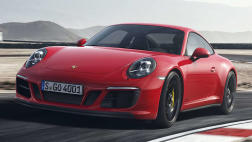The legend continues; Porsche 911 is approaching its 50th birthday and has appealed to many generations of drivers over the decades.
VALUE
A price tag of $268,550 for the Carrera S with the optional PDK automatic transmission may seem high, but compare it with supercars from Italy and its German competitors and it almost seems like a bargain.
We found fuel consumption around town to be in the 12 to 14 litres per hundred kilometres range, but on easy country roads it could easily be brought down below nine litres per hundred.
TECHNOLOGY
The Porsche Carrera S we reviewed has an improved version of the 3.8-litre flat-six engine. It now produces up to 294 kW of power. A strong emphasis on torque means the engine is amazingly flexible, with good pulling power from as low as 2000 rpm. In the ultra-high top gear of the seven-speed PDK double-clutch gearbox the engine turns at a mere 1700 revs with the 911 sitting on 110 km/h.
DESIGN
Porsche’s iconic 911 has its first all-new body in years. Obviously the new 911 looks similar to previous models – if it didn’t heads would roll in the design department after Porsche purists invaded the studio. However, it does have a distinctive shape that’s well-suited to the second decade of this millennium.
Stand the old 911 and the new side by side and you can see the body is now larger. The wheelbase has been lengthened and the track widened.
There’s slightly more interior space in the 911 than in the superseded model due to the larger body. The front seats are large and support well without being taken to the extremes of race-style seats.
Though there are four seats, those in the back of the 911 are best used only by those who are desperate for transport and simply can’t get to their destination any other way. Leave this space for extra soft luggage is our best suggestion.
Having said that, the deep luggage compartment in the front of the 911 absorbs a lot more luggage than you anticipate and can even manage a mid-sized suitcase with some soft bags around it.
SAFETY
It also sits on a new stiffer platform to further firm up handling, as well as adding safety in a crash.
DRIVING
The sound of the new 911’s engine is brilliant. Though Porsche hasn’t built air-cooled engines for many years the acoustic engineers have retained some of the sound and feel of these traditional original units. This is the sort of car that has you powering down the windows from time to time just to let you hear the echo of the car off cliffs and tunnels.
Obviously the gearing is aimed at low emissions and fuel use and at the sign of any sort of a hill the PDK immediately drops itself back to sixth gear. Fifth is selected promptly if you’re in any sort of a hurry on country roads.
Porsche 911s have the engine located in an illogical position – dangling way out behind the rear wheels, instead of within the wheelbase. This does nothing for the balance and the ultimate grip from the rear of the car, but, frankly, you have to be going really hard – preferably at a racetrack – before you can really feel things happening at the tail. Then there’s that lovely, slightly unruly feel that Porsche drivers just love.
The latest Porsche 911 uses electrically-assisted steering for the first time but the engineers have sorted it out beautifully and the feel and responsiveness are spot on. We really would have to test the cars back to back with a hydraulically-assisted steering system to try and find any real differences.
VERDICT
Those who love the concept seem sure to be more than satisfied with this new generation. Those who have never previously owned one should perhaps treat themselves to the experience one day soon.
Porsche 911 2012: Carrera
| Engine Type | Inline 6, 3.4L |
|---|---|
| Fuel Type | Premium Unleaded Petrol |
| Fuel Efficiency | 8.2L/100km (combined) |
| Seating | 4 |
| Price From | $69,960 - $80,410 |






.jpg)








-wide.jpg)





Comments